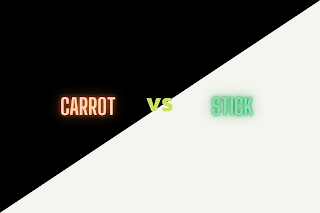The carrot and stick method for inspiration uses rewards and fines to induce desirable behavior.
This theory is based on an old story of a donkey, the best way to move him is to put a carrot in front of him and hit him with a stick from behind. In politics, "carrot or stick" sometimes refers to the realist concept of soft and hard power.
What is carrot and stick motivation?
Carrot and stick motivation is an inspirational approach that offers a "carrot" (a reward for good behavior) and a "stick" (a negative consequence for poor behavior). It motivates employees who can change their behavior and performance by creating workable goals and desirable rewards for employees. This is a simple and effective form of response for employees.
The following are the implications of the carrot and stick method:
(i) 'Carrot' invites excessive levels of ingredients, laziness in the motivation system, and low attitude towards work on the part of the individual. This happens, in particular, because a lot of the time, people get carrots, such as rewards regardless of their performance such as salary increase, seniority-based promotion, etc.
(ii) Excessive levels of 'stick' elements, retaliatory behavior on the part of the people in the system of motivation, strong organization of workers' organizations against the tyranny of management, low-quality artisans, etc.
Carrot and stick examples
Using rewards and results by which employees are truly motivated is the key to successful carrot and stick methods. If you offer rewards that no one wants or consequences that no one thinks of, employees will have no reason to work toward the goals you set.
Examples of rewards for staff members include:
To take the employee for dinner or to buy a group lunch
Allowing them to work from home for a pre-arranged period
Giving a personalized mug, water bottle, or other frequently used items as a gift
Adding a bonus to their next paycheck
Upgrade their desks, office chairs, or other everyday equipment
Going out for a group activity
Given paid time off
Publicly thanking employees (s) in company-wide emails, in person, or with handwritten notes
Giving a gift card to a service, membership, or activity that the employee will be interested in
Increase their sales commission
Your company's culture can help you decide which awards are most desirable. If your team values health and wellness, consider a spa day, a gym membership, or a massage, for example.
Be sure to balance your carrots and your sticks. Receiving rewards should be as motivating as avoiding punishment. You both need to motivate your staff members to shape their behavior and achieve the goals you set.
The potential consequences of using a carrot and stick method will vary greatly depending on the job. Here are some examples:
Loss of a portion of the employee's commission
Having to work in unfavorable shifts
Miss out on a company-wide award
One has to complete a disliked task, such as assisting in inventory or cleaning the break room.







0 Comments